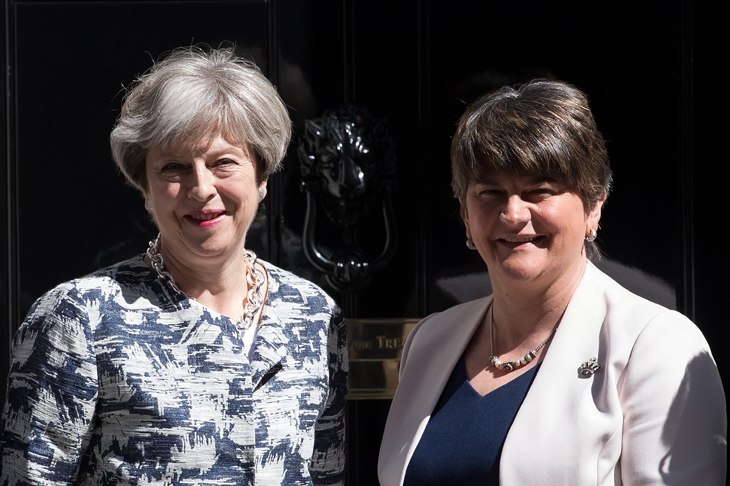The bad news for Theresa May is that Brexit isn’t over. She might have agreed terms with the European Commission and discussed these with her cabinet, but perhaps her most difficult task awaits: she must now get it through Parliament.
Even if she had struck a good deal, it would have struggled to pass. May only has a majority thanks to her confidence-and-supply deal with the Democratic Unionist Party. Northern Ireland was always going to be one of the most contentious parts of Brexit, as the EU has demanded that its future is decided first — in the legally binding withdrawal agreement — rather than in the coming UK/EU trade negotiations.
In theory, the DUP has agreed to support the Tories over Brexit. But things look different now: their language and tactics (including voting against the government, and for the publication of the legal advice on the backstop) suggest they won’t back her deal. It seems the government suspects as much, which is why the DUP appears to have been kept out of the loop with both its Westminster leader, Nigel Dodds, and Arlene Foster attacking the putative deal.
No. 10 claims victory, saying May has removed the Northern Ireland backstop by making the backstop UK-wide. However, there are still Northern Ireland-specific provisions tucked away in there.
Rather like the princess who could still feel the pea despite umpteen mattresses being placed on top of it, the DUP can sense the Northern Ireland-specific requirements buried under the UK-wide backstop. For this reason, it is highly unlikely to support the withdrawal agreement. Without DUP support, the vote begins to look very tight for May — and that’s before you even consider the many Tory rebellions she is likely to face.
The first will come from Brexit ultras who don’t regard her deal as a proper Brexit. The ERG, the largest Brexiteer lobby in the party, talks about 80 MPs being opposed to the course May has embarked on, though it accepts that the whips will succeed in reducing this number, perhaps by half. After all, MPs are being asked to vote for a withdrawal agreement, not for May’s Chequers proposals. There will also be much in the political declaration to please those who favour a Canada-style free trade deal with the EU, suggesting that this might, still, be where we end up. But the backstop (which will be in the withdrawal agreement) will complicate that. A more cautious view would be that 20 Brexit-supporting Tories will vote against May’s deal.
They will face blood-curdling threats from No. 10, including a second referendum or a general election. They’ll be called ‘purists’ who endanger the whole Brexit project. But most of these 20 MPs view the deal May is proposing as genuinely worse than EU membership, so they are not so scared of a second referendum. Compounding this problem is bullishness in Brexiteer circles that they would actually win a second vote. The threat of a Jeremy Corbyn government, though, might prove to be a rather more effective way of whittling down this number. When May was trying to win over one wavering cabinet minister, she majored on the dangers of a Corbyn government rather than the risk of a second referendum. And with some success.
But it won’t only be Tory Brexit ultras voting against the deal, as Jo Johnson’s resignation showed. It will also be opposed by some on the opposite wing of the party. Emboldened by the language of those on the Brexit side, they will argue that May’s deal is worse than EU membership so Britain should abandon Brexit and stay in.
There were always going to be a few Tories who fell into this category. But what will worry No. 10 is that this number appears to be growing. It currently looks closer to a dozen than half a dozen. There is a feeling that the criticisms by the ERG and Boris Johnson give them covering fire, meaning that it is harder to equate voting against whatever May brings back with disrespecting the referendum result. If some of those who campaigned hardest for Brexit regard this deal as a betrayal, then itis easier to argue that the public deserve another crack at it.
These Tory rebellions mean that the government will need Labour votes to get the deal through. This will not be easy. Not even all the Labour Brexiteers can be relied on by May. Kate Hoey, for instance, opposes the deal because of what it would mean for Northern Ireland.
One set of Labour MPs that the government might have some success with are those who were moderate Remainers in 2016 but represent heavily Leave seats and so don’t want either a second referendum or a general election fought on Brexit. The chief whip told colleagues recently that he thought there were 15 Labour MPs who the government could win over.
Some ministers think they could secure more Labour MPs than that. They point out that 15 voted with the government against EEA membership, which would require free movement, back in June, and that didn’t involve squeezing every last drop out of the Labour lemon. They reckon that this deal, which will mean the end of free movement once the transition period is over, could garner support from as many as 25 Labour MPs.
But even that would not be enough if the DUP is opposed, unless the Tory rebellion can be considerably shaved down. At the same time, no whip ever likes having to rely on MPs from another party. This applies particularly to Labour MPs, given the current circumstances. A huge number of them are jittery about being deselected. Any Labour backbencher who votes for May’s Brexit deal knows that he or she would infuriate both the Corbynite and pro-Remain wings of the membership, thereby making their lives extremely difficult.
How then might this deal get through the Commons? One theory that is already being discussed by cabinet ministers is that it might take two votes. In this scenario, after the first vote, rejecting it, the markets panic and MPs are staring over the abyss, so they have a second vote at which it passes. This would be, to put it mildly, high risk. But it is hard to see how the deal could, in other circumstances, pass, given the forces now ranged against it.







Comments